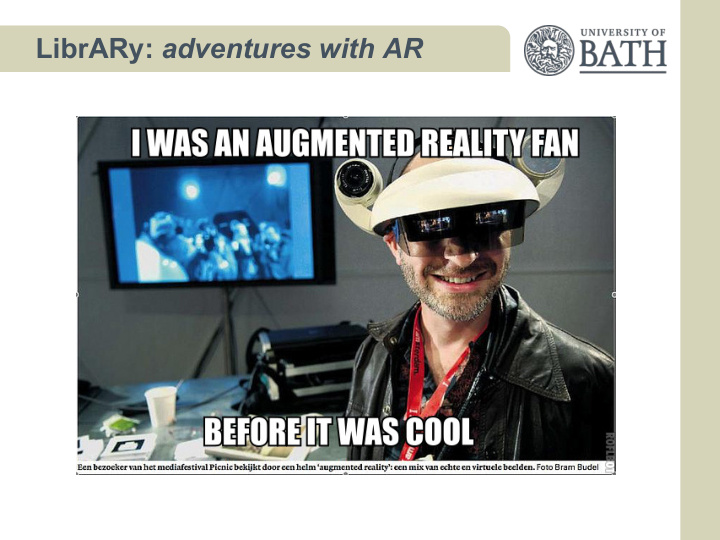



LibrARy: adventures with AR
Augmented Reality: An ‘app’ which adds a layer to what you see when looking through your phone or tablet at an object, a poster or perhaps even a building. The Observer newspaper: Sunday 21 March 2010
Enthusiasts: • Archives • E-learning • Library • Public Engagement • Students Union
Experiments: • identify a range of small scale projects • use the technology and explore options • publicise widely and share
Projects: • augmenting an image • augmenting an object • augmenting the campus
How did we do it? • Considered our options • Talked to others: education & commercial • Took a ‘pragmatic’ approach
What was the response? • Enthusiasm • Excitement • ‘High profile’ • On-going interest
Now for the technical bit …
Augmented Reality tools
Aurasma Studio
Augmenting the Campus Driven by a request from student body Raising visibility of publicly-available printer and PC locations across campus Issues using GPS coordinates in a restricted area and within buildings Concerns around accuracy of available information
Images of Research A public exhibition held across the city of Bath. Researchers explain their work using an image and a short description. Gives insight into the wide range of research being undertaken at the University of Bath. Showcases how research activity makes a difference to society and produces real benefits.
Images of Research For the 2013 exhibition “Six of the posters feature augmented reality. See a new dimension to these images with the free Aurasma app, available on certain smartphones. Once you've installed the app, open your browser and visit: http://go.bath.ac.uk/iraura13 to follow the Images of Research channel.”
Images of Research 2013 3-D beehive Understanding melanoma through colourful fish Dr Mark Greco, Department of Biology & Biochemistry Alberto Lapedriza, Department of Biology & Biochemistry Here is a 3-D x-ray of the inside of a beehive. Honeybees play a vital role in global ecological networks and provide significant social and economic benefits to humans by maintaining biodiversity in landscapes through When the cells that give colour to our skin, called melanocytes, lose their normal stable behaviour and start to grow pollinating wild plants and crops. The decline in honeybees is impacting on global ecology and economy and out of control invading nearby tissues they originate melanoma, one of the most aggressive kinds of cancer. This could reach global financial losses of more than 310 billion Euros per year. In recent years, unsustainable transformation from healthy to cancerous cell is caused by the aberrant activation of some genes that are only active agriculture, habitat degradation and an increased exposure to pathogens have placed significant pressures on in the normal melanocyte development in the embryonic stages of the organism. My research aims to understand many species of bees, creating widespread global declines in bee populations. My novel methods explore the how the genes regulating normal melanocyte development work in order to understand why their abnormal activation intricate detail of the inside of honeybee colonies. The yellow portions in the image are honey stores, orange leads to melanoma. For that, I’m using the embryos from a fish called ‘zebrafish’. I stain them with different fluorescent portions are brood, wax is shown in purple and we can see adult honey bees on the periphery of the hive. We substances to detect the genes involved in normal melanocyte development in order to understand why they work can now accurately observe what is happening inside the hive non-invasively. abnormally in melanoma. This will provide us with new targets for treatment. research research matters matters http://go.bath.ac.uk/ymsk http://go.bath.ac.uk/k3w9
Any Questions? Kate Robinson, University Librarian k.m.robinson@bath.ac.uk Marie Salter, E-Developments Manager m.salter@bath.ac.uk Nitin Parmar, Learning Technologist n.r.parmar@bath.ac.uk
Recommend
More recommend